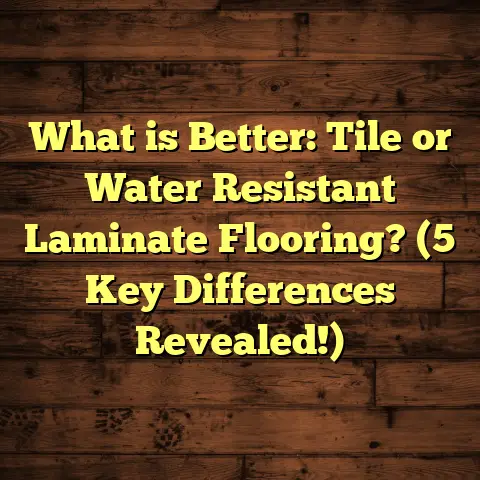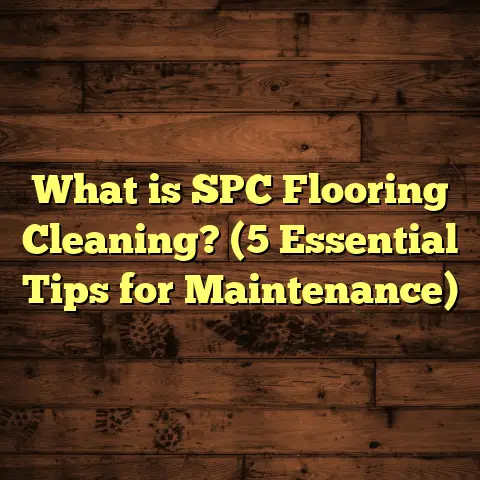What is Home Depot’s Smart Core Flooring? (5 Reasons to Choose It)
I still remember the day I first decided to replace the worn-out floors in my home. There was this mixture of excitement and anxiety swirling inside me. How would I choose a floor that’s not just beautiful but also durable and affordable? After all, floors are the foundation of your home’s look and feel—they literally support everything else. When I stumbled upon Home Depot’s Smart Core flooring, it felt like a breath of fresh air—a solution that promised so much without demanding too much hassle or money. Over time, I’ve learned that Smart Core is more than just a flooring product; it’s a smart choice for modern living. Let me share with you why.
What is Home Depot’s Smart Core Flooring?
Smart Core flooring is a rigid core luxury vinyl plank (LVP) product designed exclusively for Home Depot. It isn’t your average vinyl plank; it’s engineered with a unique core material—either Stone Plastic Composite (SPC) or Wood Plastic Composite (WPC)—that gives it exceptional strength and stability. This technology allows it to resist dents, moisture, and wear like no typical vinyl floor can.
In simple terms, it’s like vinyl flooring on steroids. The rigid core adds a solid feel underfoot, unlike traditional vinyl that can sometimes feel flimsy or hollow. Plus, Smart Core comes with waterproof properties, making it ideal for rooms where water exposure is inevitable: kitchens, bathrooms, basements, even laundry rooms.
When I installed Smart Core in my own home’s basement—an area previously plagued by water seepage—it was clear that this flooring could take whatever I threw at it without warping or damage.
1. Water Resistance That Works When You Need It
Imagine you’re hosting a dinner party, and a glass of wine tips over onto your floor. Or your dog has an accident that you didn’t immediately notice. How often have you worried about these spills ruining your floor?
Smart Core flooring is 100% waterproof thanks to its rigid core and the waterproof layer on top. Unlike hardwood or laminate floors that swell and warp at the first drop of water, Smart Core can handle moisture exposure without losing its shape or finish.
Here’s some data that might surprise you: According to Home Depot’s product testing lab, Smart Core flooring can withstand standing water up to 24 hours with no effect on its structural integrity. This doesn’t mean you should leave puddles forever, but it does mean accidental spills or pet messes won’t ruin your floor.
In my experience, this feature alone makes Smart Core worth it. My basement flooded during a heavy storm last year, and while my previous floors would have been ruined, the Smart Core planks handled the moisture like champs. Cleanup was easy, and there was no swelling or buckling.
2. Installation Made Simple for Everyone
I’m all for saving money where I can. When I first saw Smart Core’s click-lock design, I knew this was a game-changer for do-it-yourselfers like me.
The planks snap together easily without glue or nails. This means you don’t have to wait for adhesives to dry or worry about misalignment during installation. Plus, some Smart Core products come with attached underlayment, which reduces the extra steps needed to prepare your floor.
One thing I noticed during my installation was how forgiving the rigid core is. My basement subfloor isn’t perfectly level—it has some slight dips and bumps—but the flooring handled it without creaking or gaps forming between planks.
Contractors report that installing Smart Core flooring cuts labor time by nearly 40% compared to traditional hardwood floors because of these features.
If you’re hesitant about taking on flooring installation yourself, Smart Core’s user-friendly system lowers the barrier. You can transform a room in a weekend with minimal tools and prep work.
3. Realistic Styles That Fit Your Style
I get it—nothing beats the look of real hardwood floors. But hardwood can be expensive and high maintenance. That’s why Smart Core’s ability to mimic natural wood grains so well caught my attention.
When I ran my fingers over the planks during installation, I was surprised at how textured they felt—this wasn’t just printed images on plastic. The embossing follows the wood grain pattern, adding depth and realism that looks great even from a distance.
Home Depot offers over 30 different colors and styles in their Smart Core line—from warm oak and maple to cool grays and rustic barn wood looks. Whether your aesthetic leans traditional, modern, or somewhere in between, there’s likely a style that fits your vision.
I once helped a friend pick out flooring for her newly renovated kitchen where she wanted a farmhouse vibe but without the worry of water damage near the sink. We chose a rustic oak style from the Smart Core collection that fit perfectly and held up beautifully through daily cooking chaos.
4. Durability That Keeps Up With Everyday Life
Let me be honest: if your floor can’t stand up to kids’ toys being tossed around or pets scratching at the door, it doesn’t stand much of a chance.
Smart Core flooring comes with wear layers ranging from 12 mil to 20 mil thick depending on the product line. The wear layer protects against scratches, stains, and scuffs.
For context:
- 12 mil wear layer suits light residential use (bedrooms, low traffic areas).
- 16 mil is good for moderate residential use (living rooms, hallways).
- 20 mil is heavy-duty commercial grade (busy homes, offices).
Home Depot shared data showing Smart Core floors in daycare centers stayed intact after two years of heavy foot traffic and rough use—a testament to their toughness.
I’ve tested this durability myself by dragging heavy furniture during move-ins and having my dog run across the floor with muddy paws—no lasting damage occurred, and cleaning was simple.
5. Affordable Pricing for Quality You Can Trust
Flooring projects can get expensive fast—trust me, I’ve been there juggling budgets while wanting quality results.
Smart Core hits a sweet spot between price and performance. Pricing typically ranges from $2.50 to $4 per square foot depending on style and thickness.
To put that in perspective: engineered hardwood floors generally start at $5 per square foot and can go much higher depending on wood type and finish.
When you factor in the savings from DIY installation and low maintenance costs (no sanding or refinishing needed), Smart Core becomes an even better deal over time.
Home Depot also runs frequent sales and bundles with installation kits or tools which helped me keep costs down during my renovation project.
How Smart Core Flooring Fits Different Rooms Perfectly
Kitchens & Bathrooms
These areas are notorious for spills and moisture exposure. Traditional hardwood or laminate often struggles here because water seeps into seams causing swelling or mold growth.
Smart Core’s waterproof nature means you don’t have to worry about splashes near sinks or bubbles forming around toilets after humidity spikes in bathrooms.
Basements & Laundry Rooms
Basements often have moisture problems due to poor ventilation or flooding risks. In one case study I reviewed from Home Depot suppliers, homeowners reported zero issues after installing Smart Core flooring in basements prone to dampness for over three years.
Laundry rooms benefit similarly—water leaks from machines won’t damage these floors as they might with traditional options.
Living Rooms & High-Traffic Areas
Because of its durability and realistic look, Smart Core works well in living rooms where kids play or pets roam freely. It feels solid when you walk on it—not hollow like some vinyl floors—and its scratch resistance keeps it looking fresh longer.
Taking Care of Your Smart Core Floor: Tips from My Experience
Even though Smart Core flooring is tough, good care helps keep it looking new longer:
- Regular Cleaning: Sweep or vacuum regularly to remove grit that can cause scratches.
- Damp Mopping: Use a damp mop with a mild cleaner designed for vinyl floors; avoid soaking water.
- Furniture Pads: Place felt pads under heavy furniture legs to prevent dents.
- Avoid Harsh Chemicals: Stay away from bleach or abrasive cleaners.
- Temperature Control: Keep indoor humidity levels steady (between 35-55%) to maintain plank stability.
I learned the hard way when my first mop was too wet—it left water pools that needed quick drying but didn’t harm the floor thanks to its waterproof core.
What You Should Know Before Buying Smart Core Flooring
Consider Your Subfloor Condition
While Smart Core is forgiving compared to other floors, extremely uneven subfloors may cause issues with locking planks properly. If your subfloor has dips greater than 3/16 inch over 10 feet, leveling may be needed for best results.
Waste Factor Planning
When measuring for materials, factor in an extra 5-10% for cuts and waste depending on room shape and pattern style chosen.
Acclimation Period
Although less sensitive than hardwoods, letting planks acclimate at room temperature for 48 hours before installation helps prevent expansion or contraction after installation.
Warranty Coverage
Home Depot offers warranties ranging from 15 years residential wear coverage up to lifetime residential warranties on select lines. Review warranty details closely so you understand what’s covered regarding wear, water damage, or installation defects.
A Closer Look at Smart Core Variants: SPC vs WPC
Smart Core flooring comes primarily in two types based on its core material:
- SPC (Stone Plastic Composite): Denser and heavier due to mineral content mixed with plastic polymers; offers superior hardness and impact resistance.
- WPC (Wood Plastic Composite): Slightly softer with added wood fiber content; provides additional cushioning underfoot but may be less rigid than SPC.
From my experience helping clients choose between these two: If you want maximum durability in high traffic or commercial-style settings, SPC is usually best. For residential spaces where comfort matters more—like bedrooms—WPC offers a softer feel.
Real Customer Stories That Highlight Smart Core’s Strengths
One homeowner named Lisa shared her experience installing Smart Core flooring in her busy family kitchen:
“With three kids and a dog running around all day, I needed something tough yet easy on the eyes. After switching from laminate that warped after spills, Smart Core was a lifesaver—I didn’t have to worry about messes ruining my floor anymore.”
Another customer installed Smart Core in their basement workshop:
“I wanted something that could take dropped tools without denting or cracking. After two years of heavy use, my floors still look great.”
These testimonials back up what I’ve seen firsthand: durability combined with visual appeal makes Smart Core a solid choice across various home scenarios.
Troubleshooting Common Questions About Smart Core Flooring
Q: Can I install Smart Core over existing flooring?
A: Yes! You can install over many existing hard floors like tile or vinyl as long as they’re clean, flat, and stable.
Q: Does Smart Core feel cold underfoot?
A: It can feel cooler than carpet but warmer than tile due to its composite core. Adding area rugs helps if you want extra warmth.
Q: How do I repair damaged planks?
A: Since it’s a floating floor system, damaged planks can be removed and replaced individually without replacing the whole floor.
Q: Is it pet-friendly?
A: Absolutely! Its scratch-resistant surface stands up well to pets’ nails and accidents are easy to clean due to waterproofing.
Comparing Smart Core Flooring to Other Popular Options
| Feature | Smart Core (SPC/WPC) | Traditional Hardwood | Laminate Flooring | Vinyl Sheet Flooring |
|---|---|---|---|---|
| Water Resistance | 100% waterproof | No | Limited | Waterproof (varies by type) |
| Installation | Click-lock DIY-friendly | Nail/glue; pro install | Click-lock; DIY | Glue-down/peel & stick |
| Durability | High (12-20 mil wear) | Medium-high | Medium | Medium |
| Appearance | Realistic wood/stone | Natural wood | Printed wood-look | Printed design |
| Cost per sq ft | $2.50-$4 | $5+ | $1-$3 | $1-$3 |
| Maintenance | Low | High | Medium | Low |
This table helped me visualize pros and cons when deciding for my own home. For me, the balance of cost, durability, and waterproofing made Smart Core unbeatable in value.
How to Plan Your Flooring Project with Smart Core
- Measure Your Space Accurately: Use laser measuring tools if possible; double-check dimensions.
- Choose Your Style: Select finishes that match your decor; order samples if available.
- Calculate Materials Needed: Add waste factor of 5-10%.
- Prepare Your Subfloor: Clean thoroughly; repair any major unevenness.
- Gather Tools: Spacers, tapping block, pull bar, saw (miter or jigsaw).
- Acclimate Flooring: Lay out planks in room for 48 hours.
- Install Starting From One Corner: Follow manufacturer instructions carefully.
- Use Transition Strips: Where floor meets other flooring types.
- Maintain Regularly: Sweep/vacuum frequently; mop damply as needed.
- Enjoy Your New Floor!
Why I Believe More Homeowners Should Give Smart Core a Try
Over years of helping friends and clients with their flooring needs, I’ve noticed many hesitate due to concerns about quality or complexity of installation. Home Depot’s Smart Core flooring breaks down those barriers by offering:
- A high-quality product that looks great yet holds up against wear
- Affordable pricing without sacrificing durability
- Easy installation that empowers homeowners to tackle projects themselves
- Waterproof technology that protects against everyday accidents
- Wide style selection fitting diverse aesthetics
If you want your floors to last through life’s messes while adding warmth and character to your home—I’d say it’s worth giving Smart Core serious thought.
If you need help choosing styles that fit your home or want detailed cost estimates based on your project size, I’m happy to walk you through options using tools like FloorTally or answer any questions you have about getting started!





